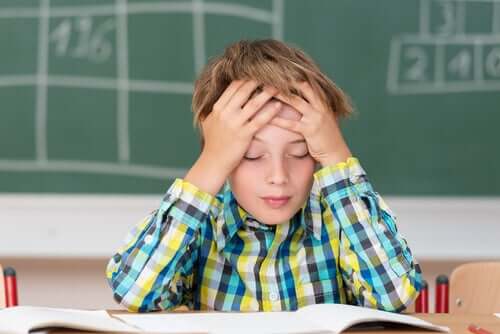Vertigo in Children: What You Need to Know

Between 60 and 80% of children under the age of three may experience vertigo in relation to an ear infection or other issue. Therefore, it’s important that parents understand the causes and symptoms of vertigo in children, and what they should do.
Does your child complain often of feelings of dizziness? Do you notice anxiety, weakness or loss of balance? If that’s the case, your child may be suffering from vertigo. Keep reading to find out more about vertigo in children.
What is vertigo?
Vertigo is a subjective sensation that your surroundings are moving or spinning, or of spinning inside your head. This sensation usually comes with nausea, faintish feelings and loss of balance.
Vertigo almost always has to do with a transformation of the vestibular system located within the inner ear. This system is responsible for coordinating the maintenance of balance and posture.
Vertigo can last for just seconds, or it can last for hours or even days. It can affect any person, and can even become chronic in the elderly. However, vertigo is almost always the result of a temporary issue.
The most common causes of vertigo in children
The causes of this disorder depend on the type of vertigo. The most common types of vertigo are peripheral vertigo and central vertigo. However, in children under the age of three, vertigo is generally the result of an ear infection. In children under 10, it’s often the result of migraine or head injury.
Benign paroxysmal positional vertigo (BPPV) is also common in small children, which is an imbalance that produces vertigo. It doesn’t cause headache or nausea, and it’s common in children between two and three years old. It may have to do with poor posture and is a very common cause of infant vertigo.

Peripheral vertigo
Peripheral vertigo is the most common type and is the result of an issue with the vestibular labyrinth or nerve. There may be swelling or pressure from a non-cancerous tumour like a meningioma.
Peripheral vertigo is related to loss of hearing and pressure in the ears. Certain medications may also produce peripheral vertigo, such as some antibiotics, cisplatin, and aminoglycosides.
Furthermore, it may be the result of head injury or Ménière’s disease.
Central vertigo
Central vertigo occurs as a result of the alteration of the neurological mechanisms of the vestibular system. On occasion, it can produce intense headaches, instability and double vision.
Central vertigo can also be the result of vascular illnesses, as well as pharmaceuticals like aspirin and some anticonvulsant drugs.
Brain injuries, migraines and tumors, both cancerous and non-cancerous, can cause central vertigo.
How to treat vertigo in children
Vertigo is a bit difficult to diagnose when it comes to children. Therefore, if your child has symptoms like constant dizziness or loss of balance, you should see a specialist as soon as possible.
Diagnosis
A specialist should perform an evaluation based on your child’s clinical history. This will include events as well as any medications your child is taking. An ear, nose and throat doctor will also examine your child.
Then, a physical exam will no doubt be necessary, including a complete neurological exam in order to evaluable brain functions. This way, doctors can determine if your child suffers from peripheral or central vertigo.
If a doctor suspects a meningeal infection, he or she will perform a lumbar puncture. Once a specialist detects the cause of your child’s symptoms, he or she will proceed with treatment.

Treatment
Treatment of vertigo in children depends on the cause as well as a child’s medical history. When it comes to an issue with the vestibular nerve, a doctor may prescribe the use of antibiotics.
These will be injected through the ear drum, pass through the middle ear, and work in the cells that affect our equilibrium.
Caring for children with vertigo
If your child suffers from the symptoms of this pathology, avoid making things worse. Your child should restrain from making sudden movements, jumping, bumpy car rides, etc.
Look for activities that he or she can do while sitting or lying down. Furthermore, during episodes of vertigo, turn off the TV and other screens as well as bright lights. These will only increase your child’s discomfort.
Vertigo in children can improve quickly if you seek the attention of a pediatrician as soon as possible. It’s also important to follow the doctor’s indication, as your child’s recovery depends on it.
Between 60 and 80% of children under the age of three may experience vertigo in relation to an ear infection or other issue. Therefore, it’s important that parents understand the causes and symptoms of vertigo in children, and what they should do.
Does your child complain often of feelings of dizziness? Do you notice anxiety, weakness or loss of balance? If that’s the case, your child may be suffering from vertigo. Keep reading to find out more about vertigo in children.
What is vertigo?
Vertigo is a subjective sensation that your surroundings are moving or spinning, or of spinning inside your head. This sensation usually comes with nausea, faintish feelings and loss of balance.
Vertigo almost always has to do with a transformation of the vestibular system located within the inner ear. This system is responsible for coordinating the maintenance of balance and posture.
Vertigo can last for just seconds, or it can last for hours or even days. It can affect any person, and can even become chronic in the elderly. However, vertigo is almost always the result of a temporary issue.
The most common causes of vertigo in children
The causes of this disorder depend on the type of vertigo. The most common types of vertigo are peripheral vertigo and central vertigo. However, in children under the age of three, vertigo is generally the result of an ear infection. In children under 10, it’s often the result of migraine or head injury.
Benign paroxysmal positional vertigo (BPPV) is also common in small children, which is an imbalance that produces vertigo. It doesn’t cause headache or nausea, and it’s common in children between two and three years old. It may have to do with poor posture and is a very common cause of infant vertigo.

Peripheral vertigo
Peripheral vertigo is the most common type and is the result of an issue with the vestibular labyrinth or nerve. There may be swelling or pressure from a non-cancerous tumour like a meningioma.
Peripheral vertigo is related to loss of hearing and pressure in the ears. Certain medications may also produce peripheral vertigo, such as some antibiotics, cisplatin, and aminoglycosides.
Furthermore, it may be the result of head injury or Ménière’s disease.
Central vertigo
Central vertigo occurs as a result of the alteration of the neurological mechanisms of the vestibular system. On occasion, it can produce intense headaches, instability and double vision.
Central vertigo can also be the result of vascular illnesses, as well as pharmaceuticals like aspirin and some anticonvulsant drugs.
Brain injuries, migraines and tumors, both cancerous and non-cancerous, can cause central vertigo.
How to treat vertigo in children
Vertigo is a bit difficult to diagnose when it comes to children. Therefore, if your child has symptoms like constant dizziness or loss of balance, you should see a specialist as soon as possible.
Diagnosis
A specialist should perform an evaluation based on your child’s clinical history. This will include events as well as any medications your child is taking. An ear, nose and throat doctor will also examine your child.
Then, a physical exam will no doubt be necessary, including a complete neurological exam in order to evaluable brain functions. This way, doctors can determine if your child suffers from peripheral or central vertigo.
If a doctor suspects a meningeal infection, he or she will perform a lumbar puncture. Once a specialist detects the cause of your child’s symptoms, he or she will proceed with treatment.

Treatment
Treatment of vertigo in children depends on the cause as well as a child’s medical history. When it comes to an issue with the vestibular nerve, a doctor may prescribe the use of antibiotics.
These will be injected through the ear drum, pass through the middle ear, and work in the cells that affect our equilibrium.
Caring for children with vertigo
If your child suffers from the symptoms of this pathology, avoid making things worse. Your child should restrain from making sudden movements, jumping, bumpy car rides, etc.
Look for activities that he or she can do while sitting or lying down. Furthermore, during episodes of vertigo, turn off the TV and other screens as well as bright lights. These will only increase your child’s discomfort.
Vertigo in children can improve quickly if you seek the attention of a pediatrician as soon as possible. It’s also important to follow the doctor’s indication, as your child’s recovery depends on it.
All cited sources were thoroughly reviewed by our team to ensure their quality, reliability, currency, and validity. The bibliography of this article was considered reliable and of academic or scientific accuracy.
- Prado Esteban, F., Macias Montero, MC, Guerrero Díaz, MT, Muñoz Pascual, A., Hernández Jiménez, MV, y Riva García, B. (2006). Mareos y vértigos. En SE de G. y Gerontología (Ed.), Tratado de Geriatría para Residentes (pp. 467–479). Madrid. https://doi.org/10.1007/s13398-014-0173-7.2
- Vázquez, G., & YacoVino, D. (2010). Trastornos del equilibrio y vértigo en neuropediatría: experiencia en un centro neurológico. Rev Hosp Niños BAires Noviembre
- Wiener-Vacher, S. (2017). Trastornos del equilibrio y vértigo en la infancia. EMC – Otorrinolaringología. https://doi.org/10.1016/S1632-3475(16)82193-1
This text is provided for informational purposes only and does not replace consultation with a professional. If in doubt, consult your specialist.








